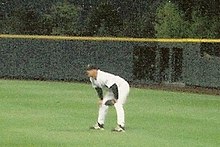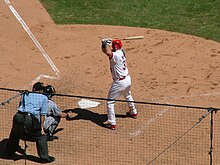Larry Walker
Widely considered a five-tool player of prodigious athleticism and instincts, Walker hit for both average and power, combined with well-above-average speed, defense and throwing strength and accuracy.
Raised in the Greater Vancouver area of British Columbia, Walker spent his youth playing street hockey with consuming NHL goaltender aspirations.
In 1997, he also led the league in home runs, OBP, and SLG, while joining the 30–30 club, registering 12 outfield assists and leading his position with four double plays turned; he won the NL MVP Award that year.
Desiring a trade to a contending team, Walker was sent by the Rockies to St. Louis in the middle of their 105-win season of 2004 where he made his first World Series appearance while tying or setting three Cardinals postseason records.
In that time, Team Canada has competed in three World Baseball Classic (WBC) tournaments, and twice at the Pan American Games, winning consecutive gold medals in 2011 and 2015.
Manager Ken Brett, who was less preoccupied with fielding a winning team than giving the athletic players the opportunity to experiment, allowed Walker to stay in the lineup as a regular in part because of his willingness to learn.
[6] Walker heard that he would be released, but Brett recalled that "he was just so tough," and marveled at his "outstanding athleticism, freakish hand-eye coordination and mental approach;"[2] he also had 12 stolen bases.
42 on Baseball America's list of top prospects in advance of the 1990 season, the Expos never optioned Walker back to the minor leagues, instead, he became their regular right fielder following Hubie Brooks' departure via free agency, patrolling an outfield which at times featured Tim Raines and Marquis Grissom, both ultra-fleet basestealers and well-accomplished hitters.
He never appeared in more than 143 games, spending significant time on the disabled list (DL) in 1991 and 1993 while playing on Olympic Stadium's notorious artificial turf, a product perceived to create excessive stress on knees, accelerating injuries to players like the former Expos star outfielder Andre Dawson.
[18] Approximately one-quarter of the way through the 1992 season, the Expos made Alou manager at the major league level, touching off a period of heightened success lasting the rest of Walker's time in Montreal.
A core of immense young talent propelled the club, including Grissom and a rising Moisés Alou (son of manager Felipe) complementing Walker in the outfield, Ken Hill and Jeff Fassero in the starting rotation and John Wetteland and Mel Rojas anchoring the bullpen.
[26][27] Now the delight of Montreal fans who had watched the team struggle through decades of futility, excitement in Canada began to crescendo over the prospect of the first-ever all-Canadian World Series, as the Toronto Blue Jays were defending champions in 1993, and repeated that October.
True to his word, when the Expos assumed the field in the bottom half of the fourth inning, Walker gave Napier a signed ball, inducing a standing ovation.
However, as the team lost millions of dollars in revenue from 29 canceled home games and playoffs, general manager Kevin Malone was given orders to drastically reduce payroll.
Nonetheless, even after mathematically adjusting for stadium and altitude advantages, his production during his Rockie years consistently rivaled other hitters whose accomplishments came in settings of greater difficulty.
[5] In his Rockies debut and inaugural game of Coors Field on April 26 versus the New York Mets, Walker doubled three times, including one that tied the score with two outs in the ninth resulting in an 11−9 extra innings win.
One of a quartet of Rockies players who became known as The Blake Street Bombers, Walker, Dante Bichette, Vinny Castilla and former Expos teammate Andrés Galarraga each contributed at least 30 home runs in 1995.
The Rockies simultaneously won the first-ever National League wild card berth under the new postseason format and first playoff appearance in franchise history in just their third season of play.
[47] The incident momentarily drew mirth and laughter from players in both dugouts, fans and announcers, and comparisons to Johnson pitching against John Kruk in the 1993 All-Star Game, in which he also threw over his head.
[65] Combined with 12 outfield assists, and a league-leading of both a .992 fielding percentage and four double plays turned,[34] Walker's 1997 season remains one of the finest all-around performances in recent baseball history.
[78][79] On May 19, Walker collected four hits versus the Cincinnati Reds to raise his season average to .431, but the Rockies were on the losing end of a 24−12 final, tied for the fourth-highest run-scoring output in MLB history.
[86] Sometimes referred to as the "Slash Stat Triple Crown," he became the seventh player within the previous 60 years to lead the league in each of average, OBP and SLG in the same season, and first since George Brett in 1980.
[5] His first three home runs of the season (video Archived February 6, 2017, at the Wayback Machine) came on June 25, 2004, versus the Cleveland Indians, including one off José Jiménez which won the game in the 10th inning for a 10−8 margin.
[107] He hit behind a speedy Tony Womack and in front of the 3−4−5 hitters of Jim Edmonds, Albert Pujols and Scott Rolen,[108] who combined for 122 home runs and 358 RBI that year.
The transition was a feat even more impressive considering he only began playing organized baseball after graduating high school and did not attend college,[2] and maintained staggering productivity over the course of his career in spite of myriad injuries.
[120] Rival right fielder and long-time San Diego Padre Tony Gwynn epitomized Walker as "the most complete player in the National League," and "best baserunner in the game" in a 2002 profile for ESPN.
[142] As Jay Jaffe noted, Walker has had difficulty gaining more support for election as he is "in something of a perfect storm" — low counting statistics relative to already-elected Hall of Famers, playing a large part of his career during the "steroid era," and taking more turns at the plate at Coors Field than anywhere else.
[143] Jaffe wrote that he found Walker to be well-qualified for induction into the Hall of Fame, contending that even though "his counting stats were low for the era, ... his all-round greatness added a considerable amount of hidden value that made up for lost time.
[146] Noted of Walker's proper swing balance by the authors of Lau's Laws on Hitting, "don't be fooled into thinking that all of his glowing statistics are the result of playing at Coors Field.
Populating the list are two of the top three home run hitters in history (Babe Ruth, 163.1; and Hank Aaron, 142.6), Musial (128.1), Mel Ott (107.8), Frank Robinson (107.2), Roberto Clemente (94.5) and Al Kaline (92.5).


